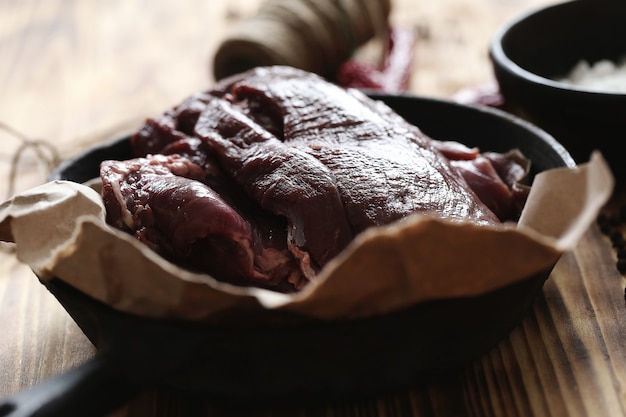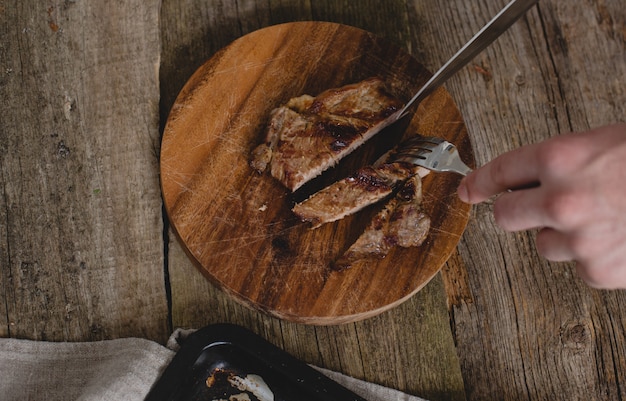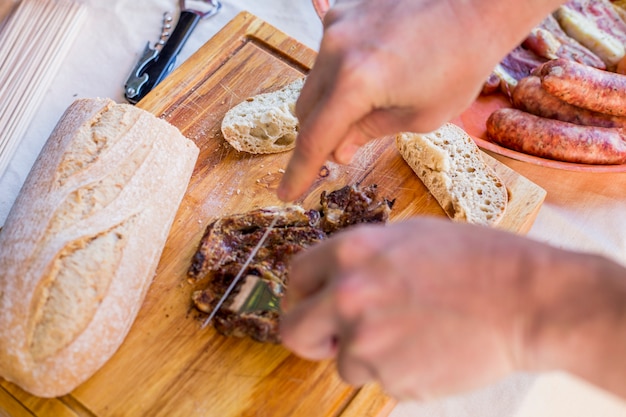You know that feeling, the one that hits you when you're scrolling through Instagram and see a photo of a perfectly seared, juicy new york strip steak? Yeah, that feeling. It's a feeling of pure culinary desire, a longing for that rich, flavourful experience. I've been there, trust me. But let's be honest, sometimes you just don't have the time, the energy, or the fancy equipment to make that happen on the grill. That's where the oven comes in, my friend. It's a true game changer, offering a simple, foolproof way to achieve restaurant-worthy steak at home.
I'm not talking about dry, overcooked meat. We're talking about tender, juicy steaks with a perfectly crisp crust. This isn't just about the final product, it's about the journey, about mastering the art of oven-baked perfection. So grab your apron, let's dive in and unlock the secrets of achieving a flawless oven-baked New York strip steak.
(Part 1) The Power of the Oven

For years, I was a grill-only kinda guy. I mean, who doesn't love that smoky flavour, those beautiful char marks? But then, life happened, and I found myself needing a more reliable and convenient method. That's when the oven became my new best friend.
The Advantages of Oven-Baking
Let's be honest, the oven offers a ton of benefits:
- Consistent Results: No more guessing whether the fire's too hot or too cold. The oven gives you consistent heat, ensuring even cooking every time. No more worrying about uneven cooking or flare-ups that can ruin your steak.
- Easier Cleanup: Forget about the smoky grill mess. Oven baking leaves you with minimal cleanup, letting you focus on enjoying your meal. No more scrubbing the grill grates or dealing with a smoky kitchen.
- Versatility: You can bake multiple steaks at once, making it perfect for feeding a crowd. This is especially helpful when you're entertaining guests or having a family dinner.
- Control Over Temperature: Oven baking gives you precise temperature control, allowing you to achieve the desired level of doneness. You can easily adjust the temperature to ensure your steak is cooked to your liking, whether you prefer rare, medium-rare, or well done.
And the best part? It's super easy!
(Part 2) Selecting the Right Steak

You know what they say: "You can't make a silk purse out of a sow's ear." The same applies to steak. choosing the right cut is crucial for achieving that juicy, flavorful result.
The New York Strip: A Classic Choice
For oven baking, the New York strip is a champion. It's known for its generous marbling, which translates to incredible flavour and tenderness. The marbling, those beautiful streaks of fat, melt during cooking, infusing the meat with rich flavour and keeping it moist. Plus, it's a versatile cut, perfect for both casual weeknight dinners and special occasions.
Choosing the Perfect Cut
Here's what to look for when selecting your New York strip:
- Marbling: Aim for a good amount of white streaks running through the meat. This indicates a rich, flavorful steak. More marbling generally means a more flavorful and tender steak, so don't be afraid to choose a steak with a good amount of marbling.
- Thickness: A 1-inch thick steak is ideal for oven baking. It ensures even cooking and a juicy centre. This thickness allows the steak to cook evenly without becoming too dry on the outside.
- Color: Look for a bright red colour with a good amount of marbling. Avoid steaks that are pale or have a dull appearance. A vibrant red colour indicates fresh meat. A pale or dull colour could mean the meat has been sitting for too long and might not be as flavorful.
If you're feeling adventurous, try using a ribeye or a sirloin. Both are equally delicious and will hold up well in the oven.
(Part 3) Prepping the Steak: The Foundation for Success

Think of prepping your steak as laying the foundation for a house. A strong foundation ensures a beautiful and sturdy structure. The same applies to your steak.
Patting Dry: A Key Step
The first step? Pat your steak dry with paper towels. This removes excess moisture, preventing steaming and ensuring a crispy crust. Moisture on the surface of the steak can create steam, preventing the formation of a nice, crispy crust. By patting it dry, you're ensuring that the heat can directly contact the meat and sear it properly.
Salt and Pepper: The Classic Duo
Next comes the seasoning. Keep it simple: salt and pepper. Don't overthink it. I like to use kosher salt, but you can use any salt you prefer. Generously season the steak on both sides, making sure the salt penetrates the meat. The salt will draw out moisture, then reabsorb it, resulting in a more flavorful and tender steak. This process is called "salt curing" and it helps to break down the muscle fibres, making the steak more tender. Seasoning the steak ahead of time also allows the salt to penetrate the meat more effectively.
A Little Bit of Oil: The Secret Weapon
Before you throw the steak in the oven, give it a light coating of oil. This helps create a beautiful, golden-brown crust. Olive oil is my go-to, but you can use any neutral oil you like. This thin layer of oil helps to create a barrier between the steak and the hot pan, preventing the steak from sticking and allowing for even browning.
(Part 4) The Magic of the Oven
Now we're getting to the good stuff, the part where we unleash the oven's magic.
Preheating is Key
Preheating your oven to 400°F (200°C) is absolutely essential. This ensures the steak cooks evenly and quickly. While your oven is preheating, grab a cast iron skillet. It's the perfect vessel for getting that crispy crust we all crave. The cast iron skillet's ability to retain heat is ideal for achieving a beautiful sear on the steak.
Searing: Creating a Flavorful Crust
Here's where things get fun. Place your skillet in the preheated oven for 5-7 minutes, allowing it to heat up. This is important because a hot skillet will sear the steak quickly, creating a crispy, flavorful crust. Once the skillet is screaming hot, carefully remove it from the oven. Now, we're ready to sear. Place the steak in the skillet and sear for 2-3 minutes per side. This process creates a beautiful, flavorful crust, locking in those juices. The sear also helps to create a barrier, preventing the juices from escaping during the cooking process.
Baking to Perfection
After searing, transfer the skillet with your steak back into the oven. Bake for 8-12 minutes, depending on the thickness of your steak and your desired level of doneness. It's time to use that trusty meat thermometer. The oven will continue to cook the steak to your desired level of doneness, while the sear helps to retain moisture and flavor.
(Part 5) Checking for Doneness
Doneness is a personal preference, but we want to ensure that the steak is cooked to your liking. No one wants a tough, dry steak.
Using a Meat Thermometer
The most accurate way to check for doneness is with a meat thermometer. Simply insert the thermometer into the thickest part of the steak. Here's a general guide for desired doneness temperatures:
| Doneness | Temperature |
|---|---|
| Rare | 125°F (52°C) |
| Medium Rare | 135°F (57°C) |
| Medium | 145°F (63°C) |
| Medium Well | 155°F (68°C) |
| Well Done | 160°F (71°C) |
It's important to remember that the temperature will continue to rise a few degrees after you remove the steak from the oven. So, pull the steak out a few degrees below your desired doneness. This is known as "carry-over cooking". By removing the steak a few degrees below your desired temperature, you allow the internal temperature to reach your desired level of doneness as the steak rests.
(Part 6) Resting: Letting the Steak Relax
You've done the hard work, now it's time to let the steak relax. Resting is crucial for ensuring that the juices redistribute evenly throughout the meat, resulting in a more tender and flavorful steak.
Why Resting Matters
As the steak cooks, the muscle fibres contract, trapping the juices inside. When you slice into a steak that hasn't been rested, those juices run out, leaving you with a dry and disappointing result. Resting allows the juices to redistribute throughout the meat, making it incredibly tender and flavorful. This is because the muscle fibres relax as the steak cools, allowing the juices to redistribute throughout the meat, resulting in a more tender and succulent steak.
How to Rest Your Steak
Simply transfer the steak to a cutting board and loosely tent it with aluminum foil. Let it rest for at least 10 minutes before slicing and serving. Resist the temptation to cut into it right away! This will help the steak to retain its moisture and flavor. It may seem like a small detail, but resting your steak is a key step in achieving that perfect, juicy result.
(Part 7) Serving and Enjoying Your Masterpiece
The moment you've been waiting for has arrived: the grand finale. It's time to enjoy the fruits of your labour.
Slicing and Serving
After resting, slice the steak against the grain. This makes it easier to chew and creates a more tender texture. Serve it with your favourite sides and condiments. Cutting against the grain helps to break down the muscle fibers, making the steak more tender and easier to eat.
Get Creative with Toppings
Don't be afraid to experiment with toppings. Here are a few ideas:
- Classic Butter: A simple pat of butter melts beautifully on top, adding richness and flavour. Butter adds a touch of richness and creaminess that complements the steak's savory flavors.
- Garlic Herb Butter: Elevate your butter with minced garlic, chopped herbs, and a sprinkle of salt and pepper. Garlic and herbs add a vibrant and aromatic flavor profile to the steak, enhancing its overall taste.
- Blue Cheese Crumble: For a bolder flavour, try a sprinkle of crumbled blue cheese. Blue cheese provides a pungent and salty contrast to the steak's richness, creating a complex flavor experience.
- Arugula Pesto: A refreshing and flavorful topping that complements the steak beautifully. The peppery arugula and nutty pesto create a bright and savory counterpoint to the steak's richness.
- Horseradish Cream: A tangy and creamy topping that adds a kick to your steak. Horseradish cream adds a spicy kick and creamy texture that complements the steak's flavor profile.
The beauty of cooking is that it allows you to express your creativity. Don't be afraid to try different toppings and find what you like best. Experimenting with flavors is part of the fun!
(Part 8) FAQs: Your Oven-Baking Questions Answered
Here are some of the most common questions about oven-baking steak, answered for you.
1. Can I use a different cut of steak?
Absolutely! While the New York strip is a classic choice, you can use other cuts like ribeye, sirloin, or even a tenderloin. Just adjust the baking time depending on the thickness of your cut. Rib eye, sirloin, and tenderloin are all excellent choices for oven-baking, offering different flavor profiles and levels of tenderness. Remember to adjust the cooking time based on the thickness of the steak.
2. What if my oven doesn't have a cast iron skillet?
No worries! You can use a regular baking sheet or a heavy-bottomed pan. Just preheat the pan in the oven for 5-7 minutes before adding the steak. A heavy-bottomed pan will retain heat more effectively than a standard baking sheet. This will help to achieve a good sear on the steak.
3. How do I know if the steak is cooked to my liking?
Use a meat thermometer to ensure accurate doneness. It's the best way to avoid overcooking or undercooking your steak. A meat thermometer is a reliable tool that gives you a precise reading of the internal temperature, ensuring that your steak is cooked to your liking.
4. Can I add other seasonings to my steak?
Of course! You can experiment with different seasonings like garlic powder, onion powder, paprika, or even a dry rub. But keep in mind that less is often more. While you can add additional seasonings to your steak, it's essential to start with a good base of salt and pepper, and then experiment with other flavors to your liking. Too many seasonings can overwhelm the steak's natural flavors.
5. What are some good side dishes to serve with oven-baked steak?
The possibilities are endless! Some classic side dishes include roasted vegetables, mashed potatoes, asparagus, or a simple salad. You can also get creative with your sides and try something new. The beauty of cooking is in the experimentation, so don't be afraid to try new things and create your own unique combinations. Think about the flavors that complement the steak and create a well-balanced meal.
There you have it, a complete guide to oven-baking the perfect new york strip steak. Remember, practice makes perfect, and there's always room for experimentation. So, get out there, grab your ingredients, and unleash your inner chef. You've got this!
Everyone is watching

Perfect Rice Every Time: The Ultimate Guide to Cooking Rice
Cooking TipsAs a self-proclaimed foodie, I've always been a bit obsessed with rice. It's the foundation of countless cuisi...

Prime Rib Roast Cooking Time Chart: Per Pound Guide
Cooking TipsPrime rib roast. Just the name conjures images of lavish dinners, crackling fires, and hearty laughter. It’s ...

The Ultimate Guide to Cooking Asparagus: Tips, Techniques, and Recipes
Cooking TipsAsparagus. The mere mention of this spring delicacy conjures up images of vibrant green spears, crisp and burs...

Ultimate Guide to Cooking the Perfect Thanksgiving Turkey
Cooking TipsThanksgiving. Just the word conjures up images of overflowing tables laden with delicious food, the scent of r...

How Long to Bake Potatoes in the Oven (Perfect Every Time)
Cooking TipsBaked potatoes are a staple in my kitchen. They're incredibly versatile, delicious, and surprisingly easy to m...
